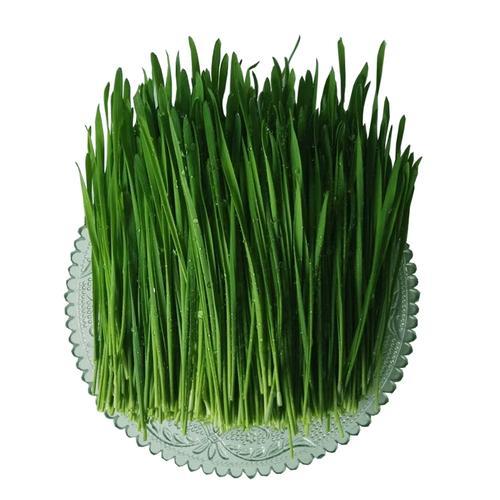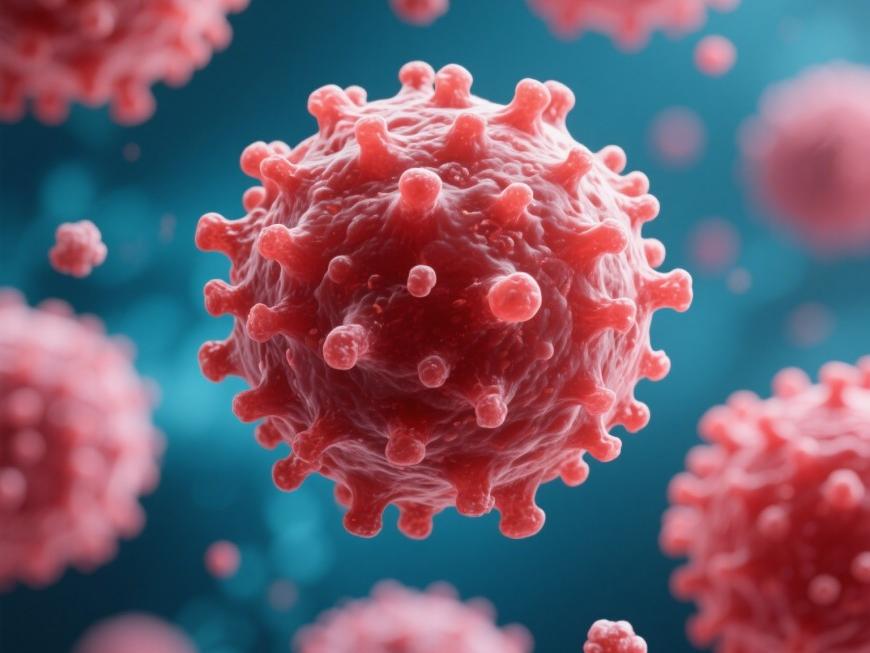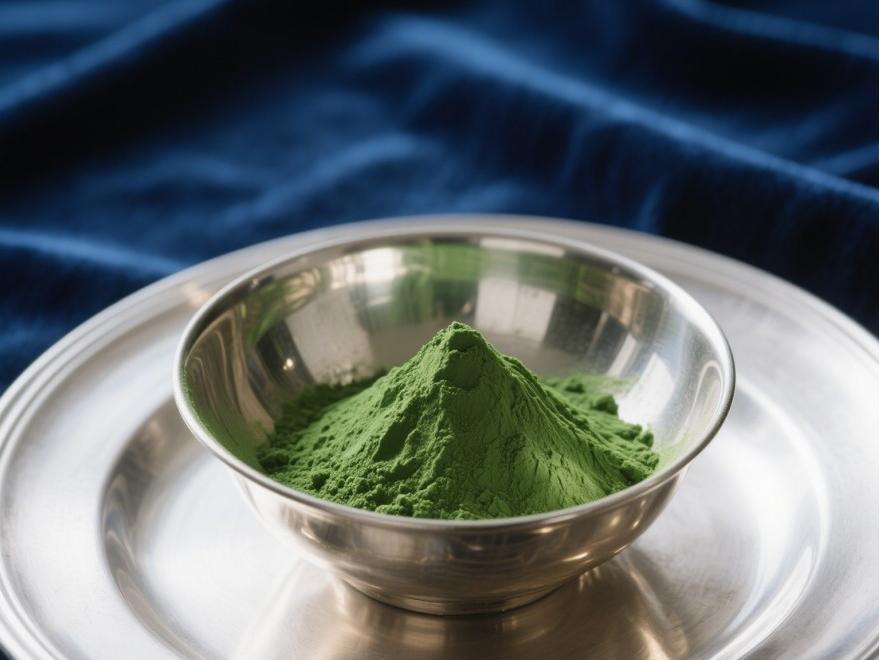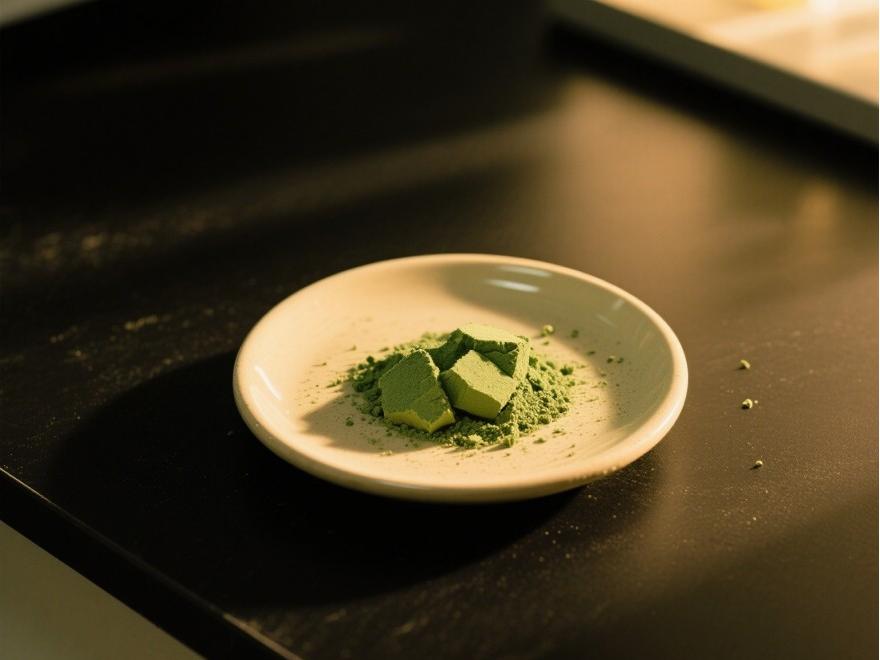What Is the Nutritional Fact of Wheat Grass?
Wheat belongs to the Poaceae family and is primarily used as feed, staple food (green barley), and raw material for beer production. Among the world's cereal crops, wheat ranks fourth in terms of total planting area and production, following rice and corn. China's wheat production bases are mainly located in the Huai River region and areas north of the Huai River. In 2012, China's wheat production was 1.8 million tons [1,2].
Wheat sprouts are rich in protein, enzymes, vitamins, minerals, chlorophyll, and other nutrients. They also have the characteristics of low carbohydrate content, low fat content, high vitamin content, high dietary fiber content, and high protein content [2]. Zhang Qiuying [4] found that consuming a small amount of wheat sprout powder daily can help improve overall health, enhance sleep quality, strengthen the heart and body, promote wound healing, detoxify the body, and delay aging. Currently, wheat sprout products in China are typically processed by cutting fresh wheat sprout stems and leaves, washing, blanching, drying, and low-temperature airflow grinding to preserve as many active nutrients as possible [5].

1 Nutritional Components of Wheat Sprout Powder
1. 1 Proteins and Enzymes
Duan Qionghui et al. [6] found that wheat sprouts are a high-protein food, containing 28.2% protein.After low-temperature airflow milling, the cell walls of wheat sprouts are broken down, releasing proteins and making them easier to digest and absorb. Wheat sprouts are rich in enzymes such as protease, amylase, superoxide dismutase (SOD), and catalase, which help the human body eliminate free radicals, promote nutrient digestion and absorption, and break down toxins in the body [7,8], thereby benefiting health.
1.2 Chlorophyll
The chlorophyll content in wheat sprouts ranges from 0.26 to 0.43 μg/100g [9]. Chlorophyll has a chemical structure similar to human hemoglobin and is often referred to as"green blood."Once chlorophyll enters the human body, iron ions replace magnesium ions in its molecules, directly converting it into hemoglobin.Wheat sprouts retain a significant amount of chlorophyll through timely blanching. Medical research has found that chlorophyll has therapeutic effects on anemia, blood pressure regulation, anti-inflammatory pain relief, and the prevention and treatment of anemia and atherosclerosis [10].
1.3 Minerals
Wheat sprouts are rich in essential trace elements for the human body, with the highest content being K, Ca, and Mg, followed by Fe, Se, and Zn, and the lowest being Cu and Mn [11]. Spinach has the highest alkalinity among fruits and vegetables at 39.6, while wheat sprout powder has an alkalinity as high as 66.4, earning it the title of"king of alkaline foods.”When minerals are in balance within the body, they are beneficial for maintaining human health [12].
1.4 Vitamins
According to analysis, wheat sprouts are a rich natural source of vitamin C, vitamin B, vitamin E, and beta-carotene.Duan Qionghui et al. found that the vitamin C and vitamin E content in barley grass powder can reach 14.9 and 6.94 mg/100g, respectively, while the vitamin B1, vitamin B2, and vitamin B6 content are 52, 244, and 175 μg/100g, respectively [6].
1.5 Other Nutrients
Barley grass powder contains a large amount of flavonoids and related compounds with strong antioxidant activity, such as 2'-O-Glyco-sylisovi-texin (2-O-GIV), which inhibits skin lipid oxidation at a rate 500 times higher than vitamin E500 times that of vitamin E, and it can prevent cancer and other diseases by scavenging active oxygen free radicals [13,14].
2 Health benefits of wheat grass powder
2.1 Lowering blood lipids
Wheat green extract is a green powder extracted from young wheat leaves using complete cell wall disruption technology and vacuum drying at room temperature, maximizing the retention of nutrients in young wheat sprouts. It contains abundant vitamins, chlorophyll, enzymes, fiber, and minerals, and has significant therapeutic effects on regulating blood sugar, preventing ulcers, and enhancing physical strength and endurance [15,16].Jin Xianyu et al. [17] administered wheat grass extract at doses of 0.33, 1.00, and 3.00 g/(kg·BW) via oral gavage to male Wistar rats for 30 days.Plasma triglycerides (TG), plasma cholesterol (TC), and high-density lipoprotein cholesterol (HDL-C) were measured at the beginning and end of the experiment to observe the effects of different doses of wheat germ extract on lipid levels in rats fed a high-fat diet.After 30 days of continuous oral administration of Maigruisu, the serum TG levels in the 3.00 g/(kg·BW·d) dose group were significantly lower than those in the control group (P < 0.05),Serum HDL-C levels in all dose groups showed no significant changes (P > 0.05).

Mao Sunzhong et al. [18] studied the effects of wheat grass extract on lipid levels and plasma malondialdehyde (MDA), superoxide dismutase (SOD), endothelin-1 (ET-1), and nitric oxide (NO) in rats with diet-induced hyperlipidemia. The results indicated that wheat germ extract could reduce the levels of low-density lipoprotein cholesterol (LDL-C) and total cholesterol (TC), increase the levels of HDL-C, significantly elevate plasma NO levels and SOD activity, while MDA and ET-1 levels were significantly reduced. This may be due to the antioxidant effect of wheat germ extract on LDL oxidation, suggesting that wheat germ extract has antioxidant, lipid-lowering, and vasodilatory effects.Chen Guitang et al. [19] reported that wheat germ extract significantly increased HDL-C and significantly reduced serum triglycerides (TG) and LDL-C, demonstrating anti-atherosclerotic effects.
2.2 Hypoglycemic effects
Diabetes has become a global public health issue. Wang Xiaojie et al. [20] established a streptozotocin-induced diabetic model and found that wheat sprouts exhibited significant hypoglycemic effects on this model. Additionally, studies revealed that minerals and chlorophyll in wheat sprouts also exhibit good therapeutic effects on diabetes [20, 21]. Furthermore,wheat sprout powder contains abundant fiber, and the intake of whole grains or grain fiber can lower blood glucose levels and reduce the risk of developing type 2 diabetes [22,23]. It can be seen that wheat sprouts have the function of regulating and balancing blood glucose levels. When blood glucose is controlled to the normal range through drug therapy, it is recommended to consume an appropriate amount of wheat sprout powder as an adjunctive therapy to maintain therapeutic effects [20].
2.3 Antitumor
Research has found that chlorophyll and its derivatives can inhibit tumor cell growth and possess anti-mutagenic activity [24]. Bez et al. [25] studied the antitumor effects of chlorophyllin (CHL), a hydrolyzed product of chlorophyll, by treating V79 cell lines with methyl methysulfate (MMS) and then adding different concentrations of CHL before, during, or after treatment, and observing the formation of micronuclei.
The results showed that adding different concentrations of CHL before, during, or after treatment could alleviate the genotoxic effects of MMS, and no genotoxic effects of CHL were observed. or after treatment with different concentrations of CHL and observed micronucleus formation. The results showed that adding different concentrations of CHL before, during, or after treatment with MMS significantly reduced the genotoxic effects of MMS, and no genotoxic effects of CHL were observed. Hirose et al. [26] treated a mouse mammary tumor model with CHL and found that the tumor incidence rate was significantly reduced.

Carter et al. [27] found that CHL can alter the expression of E-cadherin and β-catenin in human colon cancer cell line HCT-116, and these cellular differentiation markers can restrict tumor cell invasion and metastasis.Animal experiments have shown that chlorophyll has inhibitory effects on tumors induced by chemical carcinogens in the lungs, liver, intestines, skin, and breasts, making it a broad-spectrum tumor inhibitor.Jiao Guangyu et al. found that chlorophyll can alleviate the side effects of chemotherapy for malignant tumors and can serve as an adjuvant for chemotherapy [28].
Additionally, chlorophyll and its derivatives with porphyrin ring structures easily bind to carcinogens with polycyclic structures, rendering them inactive and thereby reducing their carcinogenic effects [29].Chlorophyll and CHL can also bind to proteins, DNA, and mRNA, regulating the expression of proteins related to cell differentiation, proliferation, and apoptosis [27-30], altering enzyme activity and expression within cells [31], and reducing the cell membrane's ability to transport certain carcinogenic substances [32].Additionally, the antitumor activity of wheat sprout powder is also associated with its antioxidant and free radical scavenging properties [33,34].
2.4 Prevention of constipation
During metabolism, the body continuously produces metabolic waste. If this waste is not promptly removed from the body, it accumulates and causes harm to the body. Due to the rich dietary fiber content in wheat germ powder, it helps increase stool volume, accelerate intestinal peristalsis, and promote stool excretion.
Chen Guitang et al. also found that wheat germ extract accelerates the rate of fecal excretion, indicating that wheat germ powder has a preventive effect against constipation [19].
2.5 Other Functions
Wheat germ powder is rich in vitamin E and SOD enzymes, exhibiting good antioxidant and anti-aging functions; Xie Huiping et al. [35] found that wheat germ extract can alleviate physical fatigue in mice,demonstrating anti-fatigue effects; Chen Guitang et al. [36] found that after rats were fed a diet containing wheat germ extract, the levels of uric acid and creatinine in their bodies significantly decreased [19], consistent with previous research findings, suggesting that wheat germ extract has a renoprotective effect.
3 Current Status and Prospects of Research at Home and Abroad
In the 1960s, Japanese medical doctor Ogihara Yoshihide suffered from organic mercury poisoning. He extracted juice from young wheat sprouts and consumed it daily, recovering his health in less than six months [5]. Since then, the nutritional and health benefits of wheat sprout powder have garnered significant attention, leading to extensive research on its properties and the development of various products, such as the widely popular"green juice"[37] in Japan.Today, wheat leaf products have been certified as health foods by the Japanese Health Association, and the United States has officially approved chlorophyll as a food supplement. Research on wheat sprout products in China began relatively late. In 1994, Dr. Xu Xinyue formally introduced the concept of chlorophyll from the United States to China. In 2001, the U.S. Food and Drug Administration (FDA) approved chlorophyll from China. Currently, many Chinese companies have begun independently developing wheat sprout powder products, such as"Wheat Sprout,”"Wheat Sprout Extract Powder,"and"Wheat Green Tablets"produced by a certain biotechnology company in Zhejiang Province, and"Wheat Sprout Powder"produced by a certain biotechnology company in Hangzhou. With the improvement of people's living standards and health awareness, wheat sprout products have a very broad market prospect.
References
[1] Yue Zihui. Analysis of Production Decision-Making Behavior of Barley Farmers in China [D]. Beijing: Chinese Academy of Agricultural Sciences, 2014.
[2] Zhang Lin. Study on the Supply and Demand of Barley in China [D]. Beijing: Chinese Academy of Agricultural Sciences, 2014.
[3] Zhang Qiuying, Chen Jianfeng, Zhang Shaonan. Nutritional Value of Barley Sprouts and Their Effects on the Health of White Mice [J]. Journal of Cereal Crops, 2004, 24(2): 65-67.
[4] Liu Dan, Yin Xianfeng. Overview of the Development and Utilization of Barley Sprouts [J]. Neijiang Science and Technology, 2014, 2: 94-94.
[5] Wang Fang. Nutritional Quality Analysis and Preservation of Barley Sprout Powder [D]. Fuzhou: Fujian Agricultural and Forestry University, 2009.
[6] Duan Qionghui, Li Yong, Ge Zhuxing, et al. Nutritional Component Analysis and Evaluation of Barley Sprout Powder [J]. Modern Chinese Medicine Research and Practice, 2014, 28(3): 55-57.
[7] Zhang Qiuying, Zhang Shaonan, Ye Dingsheng, et al. Wheatgrass Nutrition: A Health Supplement for the 21st Century [J]. Fujian Rice and Wheat Science and Technology, 2000, S1: 64-65.
[8] Wang Yinsong. A Brief Discussion on the Utilization Value and Cultivation Techniques of Barley Grass [J]. Fujian Rice and Wheat Science and Technology, 2000, S1: 63-64.
[9] Yang Suzhen, Wang Wei, Li Lei, et al. Research and Development of Wheat Green Health Foods [J]. Food Industry Science and Technology, 2002, 7: 94-94.
[10] Zhu Chongfa, Yang Li. The Development Potential of Wheat Green [J]. Barley Science, 2000, 3: 47-48.
[11] Hui Qiush, Li Tianlei. Determination of Trace Elements in Barley Grass and Trace Element Nutrition Analysis [J]. Chinese Practical Medicine, 2010, 5(25): 15-17.
[12]Wild S,Roglic G,Green A,et al. Global prevalence of di- abetes : estimates for the year 2000 and projections for 2030 [J].Diabetes Care,2004,27(5) : 1047-1053.
[13]Arimoto T,et al. Effect of the natural antioxidant 2 " -O- glycosylisovitexin on superoxide and hydroxyl radical genera- tion [J].Food & Chemical Toxicology An International Journal Published for the British Industrial Biological Re- search Association,2000,38(9) : 849-852.
[14]Kitta K,Hagiwara Y,Shibamoto T. Antioxidative activity of an isoflavonoid, 2 " -O-glycosylisovitexin isolated from green barley leaves [J].Journal of Agricultural & Food Chemistry,1992,40(10) : 1843-1845.
[15] Wu Hongxia, Wu Feibo, Yu Guqin, et al. Preliminary report on the screening of barley varieties suitable for chlorophyll production [J]. Journal of Cereal Crops, 2002, 22(3): 67-70.
[16] Shi Xinyou. Comparative Medicine [M]. Xi'an: Xi'an Science and Technology Press, 2003.
[17] Jin Xianyue, Zhang Daoxu. Experimental Study on the Hypolipidemic Effect of Wheat Green Pigment on Rats [J]. Chinese Journal of Food Hygiene, 2006, 18(3): 244-245.
[18] Mao Sunzhong, et al. Effects of chlorophyll on blood lipids, MDA, SOD, ET-1, and NO in experimental hyperlipidemic rats [J]. Food Science, 2007, 28(1):306-308.
[19] Chen Guitang, et al. Effects of chlorophyll on nutritional physiological functions of growing rats [J]. Food Industry Science and Technology, 2012, 33(3): 361-363.
[20] Wang Xiaojie, Yang Lihong, Shi Yali, et al. Observation of the biological health effects of barley sprouts using mouse experiments [J].Food Science, 2006, 27(12): 750-753.
[21] Huang Biguang, Liu Simao. Nutritional and health benefits of wheat germ and its development and utilization [J]. Food Research and Development, 2001, 22(5): 40-42.
[22 ]Anderson JW,Conley SB. Whole Grains and Diabetes [M]. Blackwell Publishing Professional,2007.
[23]Lindstrm J,et al. High-fibre,low-fat diet predicts longterm weight loss and decreased type 2 diabetes risk : the Finnish Diabetes Prevention Study [J]. Diabetologia,2006,49(5) :912-920.
[24] Liu, X. P., et al. Research progress on the application of chlorophyll in tumor prevention and treatment [J]. Chinese Journal of Clinical Oncology and Rehabilitation, 2007, 14(3): 269-271.
[25]Bez GC,et al. Investigation of genotoxic and antigenotoxic activities of chlorophylls and chlorophyllin in cultured V79 cells [J].Mutation Research /fundamental & Molecular Mechanisms of Mutagenesis,2001,497(1-2) : 139-145.
[26]Hirose D,Nishikawa L,Shibutani I,et al. Chemopreven- tion of het-erocyclic amine induced mammary carcinogenesis in rats [J].Environ MolMutagen,2002,39(2-3) :271-278.
[27]Orianna C,Bailey GS,Dashwood RH. The dietary phyto- chemical chlorophyllin alters E-cadherin and beta-atenin expression in human colon cancer cells [J].Journal of Nu- trition,2004,134(12 Suppl) :3441S-3444S.
[28] Jiao Guangyu, et al. Clinical study on curcumin and chlorophyll as adjuvants in the treatment of gastric cancer [J]. Journal of Nutrition, 2001, 23(3): 237-238.
[29]Smith WA,et al. Effect of chemopreventive agents on DNA adduction induced by the potent mammary carcinogen dibenzo[a,l]pyrene in the human breast cells MCF-7 [J].Mutation Research /fundamental & Molecular Mecha- nisms of Mutagenesis,2001,480-481 (5) :97-108.
[30]Blum CA,et al. Promotion versus suppression of rat colon carcinogenesis by chlorophyllin and chlorophyll : modulation of apoptosis,cell proliferation,and β-catenin / Tcf signaling
[J].Mutation Research /fundamental&Molecular Mechanisms of Mutagenesis,2003,523-524(2) :217-223.
[31]Fahey JW,et al. Chlorophyll,chlorophyllin and related tet- rapyrroles are significant inducers of mammalian phase 2 cy- toprotective genes [J].Carcinogenesis,2005,26 ( 7 ) : 1247-1255.
[32]Mata JE,et al. Effects of chlorophyllin on transport of dibenzo (a,l ) pyrene,2-amino-1-methyl-6-phenylimidazo- [4,5- b]pyridine,and aflatoxin B 1 across Caco-2 cell monolayers [J].Toxicology,2004,196(s 1-2) : 117-125.
[33]Kamat JP,et al. Chlorophyllin as an effective antioxidant a- gainst membrane damage in vitro and ex vivo [J].Biochimi- ca Et Biophysica Acta,2000,1487(2-3) : 113-127.
[34]Kamat JP,Devasagayam TPA. Oxidative damage to mito- chondria in normal and cancer tissues,and its modulation [J].Toxicology,2000,155(1-3) :73-82.
[35] Zhang Hui, Chen Zhaoliang, Qiao Yongjin. Research Progress on the Health Benefits and Processing Technology of Wheat Green Pigment [J]. Journal of Agricultural Products Processing (Chinese Edition), 2013, 19: 51-54.
[36] Jin Zenghui. Physiological Functions of Active Green Pigments from Rice and Wheat [J]. Grain and Oil, 2004, 10: 15-17.


 English
English French
French Spanish
Spanish Russian
Russian Korean
Korean Japanese
Japanese






